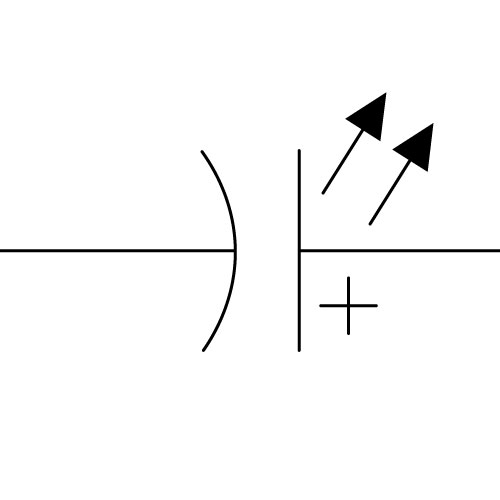INTELLECTUM VIRTUS
INTELLECTUM VIRTUS
INTELLECTUM VIRTUS
INTELLECTUM VIRTUS
INTELLECTUM VIRTUS
ELECTRICAL ENGINEERING
ELECTRICAL ENGINEERING
ELECTRICAL ENGINEERING
ELECTRICAL ENGINEERING
ELECTRICAL ENGINEERING
FARADAY’S INDUCTION LAW
FARADAY’S INDUCTION LAW
FARADAY’S INDUCTION LAW
FARADAY’S INDUCTION LAW
FARADAY’S INDUCTION LAW
FORMULA & CALCULATOR
FORMULA & CALCULATOR
FORMULA & CALCULATOR
FORMULA & CALCULATOR
FORMULA & CALCULATOR
FORMULA & CALCULATOR
FORMULA & CALCULATOR
FORMULA & CALCULATOR
FORMULA & CALCULATOR
 |
 |
 |
 |
 |
| Basic law of electromagnetic induction which states that an induced voltage will have a polarity that opposes the current change that produced it. Faraday’s law of induction: makes use of the magnetic flux $Φ_{ B }$ through a hypothetical surface $Σ$ whose boundary is a wire loop. Since the wire loop may be moving, we write $Σ(t)$ for the surface. The magnetic flux is defined by a surface integral: |
| Basic law of electromagnetic induction which states that an induced voltage will have a polarity that opposes the current change that produced it. Faraday’s law of induction: makes use of the magnetic flux $Φ_{ B }$ through a hypothetical surface $Σ$ whose boundary is a wire loop. Since the wire loop may be moving, we write $Σ(t)$ for the surface. The magnetic flux is defined by a surface integral: |
| Basic law of electromagnetic induction which states that an induced voltage will have a polarity that opposes the current change that produced it. Faraday’s law of induction: makes use of the magnetic flux $Φ_{ B }$ through a hypothetical surface $Σ$ whose boundary is a wire loop. Since the wire loop may be moving, we write $Σ(t)$ for the surface. The magnetic flux is defined by a surface integral: |
| Basic law of electromagnetic induction which states that an induced voltage will have a polarity that opposes the current change that produced it. Faraday’s law of induction: makes use of the magnetic flux $Φ_{ B }$ through a hypothetical surface $Σ$ whose boundary is a wire loop. Since the wire loop may be moving, we write $Σ(t)$ for the surface. The magnetic flux is defined by a surface integral: |
| Basic law of electromagnetic induction which states that an induced voltage will have a polarity that opposes the current change that produced it. Faraday’s law of induction: makes use of the magnetic flux $Φ_{ B }$ through a hypothetical surface $Σ$ whose boundary is a wire loop. Since the wire loop may be moving, we write $Σ(t)$ for the surface. The magnetic flux is defined by a surface integral: |
| \[Φ_{ B }=\iint _{ Σ(t) }^{ }{ B(r,t)\cdot dA } \]
|
| \[Φ_{ B }=\iint _{ Σ(t) }^{ }{ B(r,t)\cdot dA } \]
|
| \[Φ_{ B }=\iint _{ Σ(t) }^{ }{ B(r,t)\cdot dA } \]
|
| \[Φ_{ B }=\iint _{ Σ(t) }^{ }{ B(r,t)\cdot dA } \]
|
| \[Φ_{ B }=\iint _{ Σ(t) }^{ }{ B(r,t)\cdot dA } \]
|
| where $dA$ is an element of surface area of the moving surface $Σ(t)$, $B$ is the magnetic field (also called “magnetic flux density”), and $B\cdot dA$ is a vector dot product (the infinitesimal amount of magnetic flux through the infinitesimal area element $dA$). In more visual terms, the magnetic flux through the wire loop is proportional to the number of magnetic flux lines that pass through the loop. When the flux changes – because $B$ changes, or because the wire loop is moved or deformed, or both—Faraday’s law of induction says that the wire loop acquires an EMF, $\varepsilon $, defined as the energy available from a unit charge that has travelled once around the wire loop. Equivalently, it is the voltage that would be measured by cutting the wire to create an open circuit, and attaching a voltmeter to the leads. Faraday’s law states that the EMF is also given by the rate of change of the magnetic flux: |
| where $dA$ is an element of surface area of the moving surface $Σ(t)$, $B$ is the magnetic field (also called “magnetic flux density”), and $B\cdot dA$ is a vector dot product (the infinitesimal amount of magnetic flux through the infinitesimal area element $dA$). In more visual terms, the magnetic flux through the wire loop is proportional to the number of magnetic flux lines that pass through the loop. When the flux changes – because $B$ changes, or because the wire loop is moved or deformed, or both—Faraday’s law of induction says that the wire loop acquires an EMF, $\varepsilon $, defined as the energy available from a unit charge that has travelled once around the wire loop. Equivalently, it is the voltage that would be measured by cutting the wire to create an open circuit, and attaching a voltmeter to the leads. Faraday’s law states that the EMF is also given by the rate of change of the magnetic flux: |
| where $dA$ is an element of surface area of the moving surface $Σ(t)$, $B$ is the magnetic field (also called “magnetic flux density”), and $B\cdot dA$ is a vector dot product (the infinitesimal amount of magnetic flux through the infinitesimal area element $dA$). In more visual terms, the magnetic flux through the wire loop is proportional to the number of magnetic flux lines that pass through the loop. When the flux changes – because $B$ changes, or because the wire loop is moved or deformed, or both—Faraday’s law of induction says that the wire loop acquires an EMF, $\varepsilon $, defined as the energy available from a unit charge that has travelled once around the wire loop. Equivalently, it is the voltage that would be measured by cutting the wire to create an open circuit, and attaching a voltmeter to the leads. Faraday’s law states that the EMF is also given by the rate of change of the magnetic flux: |
| where $dA$ is an element of surface area of the moving surface $Σ(t)$, $B$ is the magnetic field (also called “magnetic flux density”), and $B\cdot dA$ is a vector dot product (the infinitesimal amount of magnetic flux through the infinitesimal area element $dA$). In more visual terms, the magnetic flux through the wire loop is proportional to the number of magnetic flux lines that pass through the loop. When the flux changes – because $B$ changes, or because the wire loop is moved or deformed, or both—Faraday’s law of induction says that the wire loop acquires an EMF, $\varepsilon $, defined as the energy available from a unit charge that has travelled once around the wire loop. Equivalently, it is the voltage that would be measured by cutting the wire to create an open circuit, and attaching a voltmeter to the leads. Faraday’s law states that the EMF is also given by the rate of change of the magnetic flux: |
| where $dA$ is an element of surface area of the moving surface $Σ(t)$, $B$ is the magnetic field (also called “magnetic flux density”), and $B\cdot dA$ is a vector dot product (the infinitesimal amount of magnetic flux through the infinitesimal area element $dA$). In more visual terms, the magnetic flux through the wire loop is proportional to the number of magnetic flux lines that pass through the loop. When the flux changes – because $B$ changes, or because the wire loop is moved or deformed, or both—Faraday’s law of induction says that the wire loop acquires an EMF, $\varepsilon $, defined as the energy available from a unit charge that has travelled once around the wire loop. Equivalently, it is the voltage that would be measured by cutting the wire to create an open circuit, and attaching a voltmeter to the leads. Faraday’s law states that the EMF is also given by the rate of change of the magnetic flux: |
| \[\varepsilon =\frac { d{ \Phi }_{ B } }{ dt } \]
|
| \[\varepsilon =\frac { d{ \Phi }_{ B } }{ dt } \]
|
| \[\varepsilon =\frac { d{ \Phi }_{ B } }{ dt } \]
|
| \[\varepsilon =\frac { d{ \Phi }_{ B } }{ dt } \]
|
| \[\varepsilon =\frac { d{ \Phi }_{ B } }{ dt } \]
|
| where $\varepsilon $ is the electromotive force (EMF) and ${ \Phi }_{ B }$ is the magnetic flux. The direction of the electromotive force is given by Lenz’s law. For a tightly wound coil of wire, composed of $N$ identical turns, each with the same ${ \Phi }_{ B }$, Faraday’s law of induction states that: |
| where $\varepsilon $ is the electromotive force (EMF) and ${ \Phi }_{ B }$ is the magnetic flux. The direction of the electromotive force is given by Lenz’s law. For a tightly wound coil of wire, composed of $N$ identical turns, each with the same ${ \Phi }_{ B }$, Faraday’s law of induction states that: |
| where $\varepsilon $ is the electromotive force (EMF) and ${ \Phi }_{ B }$ is the magnetic flux. The direction of the electromotive force is given by Lenz’s law. For a tightly wound coil of wire, composed of $N$ identical turns, each with the same ${ \Phi }_{ B }$, Faraday’s law of induction states that: |
| where $\varepsilon $ is the electromotive force (EMF) and ${ \Phi }_{ B }$ is the magnetic flux. The direction of the electromotive force is given by Lenz’s law. For a tightly wound coil of wire, composed of $N$ identical turns, each with the same ${ \Phi }_{ B }$, Faraday’s law of induction states that: |
| where $\varepsilon $ is the electromotive force (EMF) and ${ \Phi }_{ B }$ is the magnetic flux. The direction of the electromotive force is given by Lenz’s law. For a tightly wound coil of wire, composed of $N$ identical turns, each with the same ${ \Phi }_{ B }$, Faraday’s law of induction states that: |
| \[\varepsilon =-N\frac { d{ \Phi }_{ B } }{ dt }\]
|
| \[\varepsilon =-N\frac { d{ \Phi }_{ B } }{ dt }\]
|
| \[\varepsilon =-N\frac { d{ \Phi }_{ B } }{ dt }\]
|
| \[\varepsilon =-N\frac { d{ \Phi }_{ B } }{ dt }\]
|
| \[\varepsilon =-N\frac { d{ \Phi }_{ B } }{ dt }\]
|
| where $N$ is the number of turns of wire and ${ \Phi }_{ B }$ is the magnetic flux through a single loop. |
| where $N$ is the number of turns of wire and ${ \Phi }_{ B }$ is the magnetic flux through a single loop. |
| where $N$ is the number of turns of wire and ${ \Phi }_{ B }$ is the magnetic flux through a single loop. |
| where $N$ is the number of turns of wire and ${ \Phi }_{ B }$ is the magnetic flux through a single loop. |
| where $N$ is the number of turns of wire and ${ \Phi }_{ B }$ is the magnetic flux through a single loop. |
Discovered in 1830 by Michael Faraday. |
Discovered in 1830 by Michael Faraday. |
Discovered in 1830 by Michael Faraday. |
Discovered in 1830 by Michael Faraday. |
Discovered in 1830 by Michael Faraday. |
